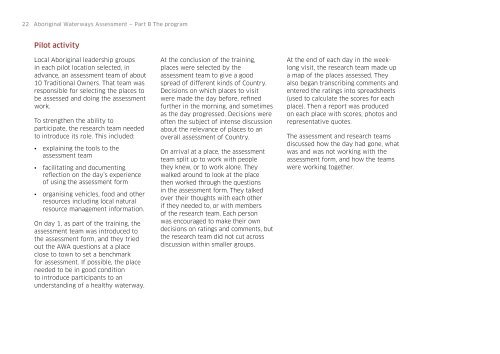Aboriginal Waterways Assessment program
dCckIF
dCckIF
Create successful ePaper yourself
Turn your PDF publications into a flip-book with our unique Google optimized e-Paper software.
22 <strong>Aboriginal</strong> <strong>Waterways</strong> <strong>Assessment</strong> — Part B The <strong>program</strong><br />
Pilot activity<br />
Local <strong>Aboriginal</strong> leadership groups<br />
in each pilot location selected, in<br />
advance, an assessment team of about<br />
10 Traditional Owners. That team was<br />
responsible for selecting the places to<br />
be assessed and doing the assessment<br />
work.<br />
To strengthen the ability to<br />
participate, the research team needed<br />
to introduce its role. This included:<br />
• explaining the tools to the<br />
assessment team<br />
• facilitating and documenting<br />
reflection on the day’s experience<br />
of using the assessment form<br />
• organising vehicles, food and other<br />
resources including local natural<br />
resource management information.<br />
On day 1, as part of the training, the<br />
assessment team was introduced to<br />
the assessment form, and they tried<br />
out the AWA questions at a place<br />
close to town to set a benchmark<br />
for assessment. If possible, the place<br />
needed to be in good condition<br />
to introduce participants to an<br />
understanding of a healthy waterway.<br />
At the conclusion of the training,<br />
places were selected by the<br />
assessment team to give a good<br />
spread of different kinds of Country.<br />
Decisions on which places to visit<br />
were made the day before, refined<br />
further in the morning, and sometimes<br />
as the day progressed. Decisions were<br />
often the subject of intense discussion<br />
about the relevance of places to an<br />
overall assessment of Country.<br />
On arrival at a place, the assessment<br />
team split up to work with people<br />
they knew, or to work alone. They<br />
walked around to look at the place<br />
then worked through the questions<br />
in the assessment form. They talked<br />
over their thoughts with each other<br />
if they needed to, or with members<br />
of the research team. Each person<br />
was encouraged to make their own<br />
decisions on ratings and comments, but<br />
the research team did not cut across<br />
discussion within smaller groups.<br />
At the end of each day in the weeklong<br />
visit, the research team made up<br />
a map of the places assessed. They<br />
also began transcribing comments and<br />
entered the ratings into spreadsheets<br />
(used to calculate the scores for each<br />
place). Then a report was produced<br />
on each place with scores, photos and<br />
representative quotes.<br />
The assessment and research teams<br />
discussed how the day had gone, what<br />
was and was not working with the<br />
assessment form, and how the teams<br />
were working together.


